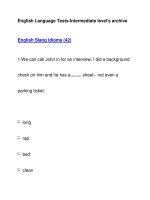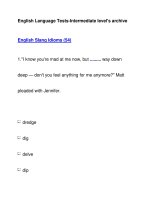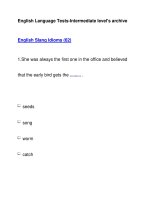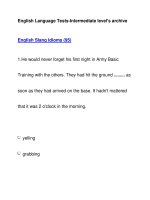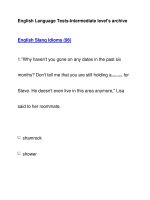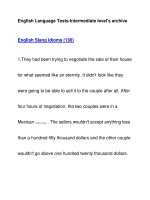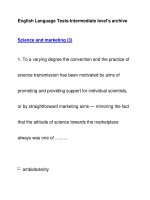English Language Tests-Intermediate level''''s archiveVocabulary Practice: Bees (2) pptx
Bạn đang xem bản rút gọn của tài liệu. Xem và tải ngay bản đầy đủ của tài liệu tại đây (79.87 KB, 9 trang )
English Language Tests-Intermediate level's archive
Vocabulary Practice: Bees (2)
1.Bees are very useful animals because they not only
make honey but they also flowers and plants. They
transfer pollen from one flower to another and this act
makes plant reproduction possible in many cases.
buy
birth
paint
pollinate
2.Many bees live together in colonies. The female bees
that do all of the work in a repetitive fashion are called
bees.
strong
worker
cohort
supporter
3.A large group of bees that are either living or travelling
together is referred to as a .
encampment
associates
swarm
herd
4.Honey are created by bees and they are a cell-like
storage container found inside hives. These structures
contain honey and the bees' offspring.
allies
bears
combs
brushes
5.Bees is secreted or released by bees and found in
hives along with honey. This substance is also collected
by bee keepers because it can be used to make candles.
It's a yellowish, plastic-type material.
wand
cream
porridge
wax
6.Some people have serious bee sting . This means
certain people have an immune reaction and symptoms
include painful itching, swelling and trouble breathing.
declines
allergies
wands
sites
7.In a bee colony, there are male bees called that
have no stinging abilities and they also don't take part in
collecting honey.
drones
experts
workers
kings
8.When parents talk to their children about reproduction in
nature, we often say that they are talking about the
and bees.
foxes
streams
birds
owls
9.Bees work very hard in nature. So, when humans work
really hard, we often say that they are as as a bee.
hairy
painful
busy
small
10.Wild bees, ones that don't live in man-made hives, are
often called bees.
feral
brush
stagnant
vile
